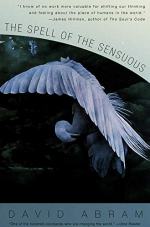|
This section contains 527 words (approx. 2 pages at 400 words per page) |

|
Spell of the Sensuous Summary & Study Guide Description
Spell of the Sensuous Summary & Study Guide includes comprehensive information and analysis to help you understand the book. This study guide contains the following sections:
This detailed literature summary also contains Topics for Discussion on Spell of the Sensuous by David Abram.
The following version of this book was used to create the guide: Abram, David. The Spell of the Sensuous. Pantheon: New York, 1996.
The Spell of the Sensuous makes the observable assertion that most humans have become unaware of or disconnected from the living, animate earth, and this disconnect has unfortunate and often disastrous consequences for beings on this planet. Abram’s inquiry is into the original reason for how the human mind disengaged from its natural surroundings thereby isolating humans from the other beings such as animals and plants on the planet.
Abram’s main premise is this disconnect took place or began to vastly widen at the introduction of the abstract alphabet. In indigenous and oral cultures, where all humans have their origins, humans are deeply rooted in the earth and established in a place. Language was always, at this time, a sensuous and bodily phenomenon. Remnants of such connection exist in the way we learn to speak a language as a child or in our personification of natural surroundings—for example, babbling brook. However, the speaking world around us became overshadowed by the internal and abstract rational mind, as epitomized by Western philosophy and modes of thinking.
The origins of the abstract alphabet are chronicled from ideograms and hieroglyphics and the Hebrew alpha-bet to the truly abstract Greek alphabet. Coincidentally, the ancient Greek philosophers such as Socrates and Plato began a quest to find the true objective reality, a realm of perfect forms. Abram outlines how this rational quest soon dwarfed the oral and indigenous knowledge—the knowledge that held the connections to the herbs and landforms, minerals and bone. The purely abstract alphabet is self-reflexive; that is, instead of humans reaching out to make connections to the beings around us, we continue to make connections with the printed word, which, in turn, reflects ourselves. We have created a closed-loop system that values the creations and language of humans.
Abram also argues that the human mind is created by the sensory field of earth rather than an essence bestowed upon us by an otherworldly existence. He explores the mythology of indigenous cultures still existing on this planet for insight. For example, the Native American Navajo tribe understands mind not as a personal possession but as a wind in which all participate. Within a certain ecosystem, the humans, animals, plants, insects and even weather patterns dwell within the same state of mind. When Abram investigates shamans and sorcerers, he argues that their gift is not a supernatural one that connects to other worlds but to the greater eco-community of plants and animals, not merely the human one.
Abram outlines the philosophers that have argued for this sensuous living, such as Edmund Husserl and Maurice Merleau-Ponty. He discusses the tenets of phenomenology which call into question the assumption of an objective reality. In phenomenology, reality is the subjective sensuous world around us with its myriad desires and sensory input is a participatory phenomenon experienced by humans on the daily basis. It is also one of interconnection where, if we fail to re-root ourselves, could well mean the destruction of the environment and, in turn, ourselves.
Read more from the Study Guide
|
This section contains 527 words (approx. 2 pages at 400 words per page) |

|



